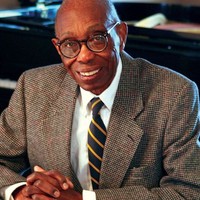Ruggero Allifranchini Plays Mozart’s Fifth Violin Concerto

Sponsored By
- April 26-27, 2019


Sponsored By


George Walker was a vital American composer who was active right up to his death in 2018 at the age of 96. Decades before he became the first Black winner of the Pulitzer Prize for Music in 1996, he broke ground in 1945 as the first Black graduate of the Curtis Institute of Music, where he studied piano with Rudolf Serkin and composition with Samuel Barber.
In an uncanny parallel with Barber, whose most celebrated music is still the Adagio for Strings adapted from the First String Quartet he wrote just after graduating from Curtis, Walker, too, is best known for the slow movement of the String Quartet No. 1 that he wrote in 1946. Originally titled Lament, and dedicated to his recently deceased grandmother, Walker renamed the movement Lyric. Whether performed in its original quartet configuration or in his transcription for string orchestra, Lyric has become a fixture of American concert music.
Aaron Grad ©2025

 Listen to Audio
Listen to Audio
Admirers of Mozart’s serenades will find much to appreciate in his five violin concerti, which together mark the pinnacle of his music for violin. In the late eighteenth century, the serenade genre, rooted in the tradition of musical courtship (think of the lover, supported by his mandolin-strumming friends, singing beneath his beloved’s window), expanded to include more public celebrations: weddings, graduations, and the like. Per Mozart’s contemporary J.A.P. Schulz: “The title ‘serenade’ is also used for purely instrumental compositions, which, to honor or congratulate specific personages, are performed at dusk in front of their houses… The composer must strive to write simple, flowing melodies, set primarily to consonant rather than dissonant harmonies.”
The violin concerti, all completed in the year before Mozart’s twentieth birthday, might be heard as an extension of the serenades that mark his early years in Salzburg (Eine kleine Nachtmusik, et al.). They are untroubled works, recalling the serenades in both their compositional style and idyllic character. Equally so, the serenades, a number of which feature virtuosic solo violin writing, foreshadow the concerti. Mozart biographer Maynard Solomon surmises that the third, fourth, and fifth concerti specifically “are the highest examples of his serenade style after it has been detached from the serenade proper and reconstituted within a separate genre.”
The Fourth Violin Concerto is set in D major: a logical choice of key for the glorification of the violin, as it capitalizes on the instrument’s natural resonance. The opening Allegro bespeaks an irrepressible joie de vivre immediately from its opening measures. The opening theme is as uncomplicatedly ebullient as a nursery rhyme: a martial succession of unison Ds and a giddy outline of a D major chord prepare the way for “simple, flowing melodies, set primarily to consonant rather than dissonant harmonies” indeed.
The Andante cantabile second movement responds to the gaiety of the Allegro with sublime beauty. Solomon describes this music as “inhabit[ing] a world of plenitude, [in which] beauty is everywhere for the taking. … [T]he beauties succeed each other with a breathtaking rapidity, their outpouring of episodic interpolations suggesting that we need not linger over any single moment of beauty, for beauty is abundant, it is to be found ‘here, too,’ and ‘there, as well.’” The concerto concludes with a playfully indecisive Rondeau: the meter vacillates between a graceful 2/4 and galloping 6/8 tempo, but the music’s prevailing lightness of spirit is assured.
Patrick Castillo ©2015
Mozart’s fifth violin concerto will also be performed April 30–May 5 in Apple Valley, Eden Prairie, Summit Hill and Mahtomedi. Click here for more information.
Get driving directions and find nearby parking.
Find dining options close to the venue.
View seating charts to find out where you'll be seating.
SPCO concerts are made possible by audience contributions.
For exclusive discounts, behind-the-scenes info, and more:
Sign up for our email club!
